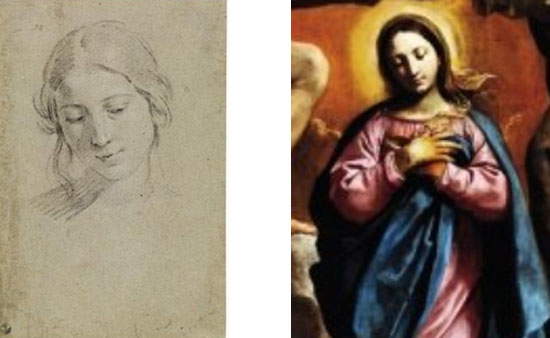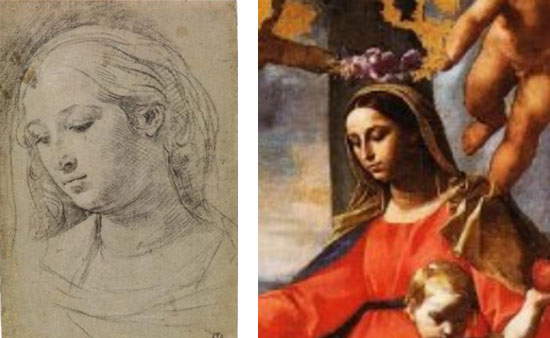Often, “laymen” are wont to attribute a lower value to drawings than to paintings: but drawing is a fundamental means of understanding the dynamics of the artist’s creative process and of getting to know his style better, as well as of drawing important information about his tastes, his studies, and his training. The drawings of a great artist like Simone Cantarini (1612 - 1648) do not escape this logic, and allow us to better frame him within the art-historical context within which he operated. A nucleus of his drawings from the Gabinetto dei Disegni e delle Stampe of the Uffizi in Florence thus allows us to understand, among other things, what were the peculiarities that distinguished the painter from Pesaro from his colleagues who worked with him in the wake of the art of Guido Reni (1575 - 1642).
 |
| Guido Reni, Head of a Young Woman (c. 1609; black and red chalk on paper; Houston, The Museum of Fine Arts) |
Simone Cantarini, while not completely severing ties with the master, comes to different conclusions. We could take, by way of example, a Head of a Young Woman from the Gabinetto dei Disegni e delle Stampe degli Uffizi (GDSU), marked by the inventory number 1661 F. A few pencil strokes, never retouched, not even once, and there the young woman’s face is already outlined: Cantarini thus proposes a stroke that has animmediacy and rapidity that we do not find in Guido Reni’s drawings. This, of course, does not make one better than the other: if Guido Reni was more inclined toward thoughtful and reflective drawing, Cantarini preferred speed of execution. A rapidity that, however, does not prevent Simone Cantarini from even an in-depth study, if you will: we must also consider the fact that this head is a study for a finished painting, namely the altarpiece of theCoronation of the Virgin made for the basilica of Santa Maria Assunta in Gandino, a village in the Seriana Valley not far from Bergamo, where it still stands today. In particular, this study is none other than the face of the Virgin that we admire in the painting. This, then, is why, despite the immediacy of the realization, the painter seems to have wanted to dwell on the study of light and shadow (in particular, we see that the shadows obscure a good half of the face): precisely because the drawing was an important rehearsal in view of a final realization.
 |
| Left: Simone Cantarini, Head of a Young Woman (c. 1642-1647; black pencil on paper; Florence, Galleria degli Uffizi, Gabinetto dei Disegni e delle Stampe, Inv. 1661 F) Right: Simone Cantarini, Coronation of the Virgin, detail (1642-1647; oil on canvas; Gandino, Basilica of Santa Maria Assunta) |
We find the same features in another drawing that is close to the Reno ones but still retains its independence: it is the Bust of a Young Woman, also from GDSU (6247 F), which again constitutes a study for an altarpiece, this time the Madonna of the Rosary for the church of San Medardo di Arcevia, in the province of Ancona. The face turned three-quarters in the drawing is the same as the Virgin in the painting: the fact that they are so similar proves to us that the Uffizi drawing is a study that would have to precede the making of the painting by a very short time. In spite of the fact that the face moves away from that formal abstraction typical of Reni to take on the features of a much more “earthly” young woman, there still remain some characteristics typical of Guido Reni’s drawing, such as the tendency to schematize the shading, which here, especially if we look at the cheeks of the young woman, also take on the appearance of a reticule, typical of academic drawings, whose lines become thicker where the detail is more in shadow.
 |
| Left: Simone Cantarini, Bust of Young Woman (c. 1642; black pencil on paper; Florence, Galleria degli Uffizi, Gabinetto dei Disegni e delle Stampe, Inv. 6247 F) Right: Simone Cantarini, Madonna of the Rosary, detail (1642; oil on canvas; Arcevia, San Medardo) |
If we want to encounter a Cantarini much farther removed from Guido Reni, we have to look at what is most likely one of his youthful drawings, made perhaps at a time when the artist had not yet developed that particular predilection for Reni’s classicism: it is a Head and Shoulder of a Young Man (1659 F in GDSU), which, unlike the two drawings seen above, strikes us with its distinct sense of naturalism. Beginning with the pose, which is anything but conventional: in drawing the subject’s shoulder, the artist shows us that the young man is bent over and turning away, probably because something has called his attention. His gaze is lively and attentive, typical of someone who has just noticed something that has diverted him from what he was waiting for, and even his mouth seems to be about to open, perhaps to answer a question. This is a young Cantarini who wants to fix an expression with immediacy but at the same time wants to study it in depth: that is why the contours are so pronounced and distinguished from the instead light and quick contours of the more mature (and if we want, even more refined) Cantarini we saw just above, and why the shading also appears softer and more nuanced. A particularly vivid naturalism that could refer on the one hand to the artist’s early experiences in the Marche region, which in his homeland he trained by studying the examples of naturalist painters such as Orazio Gentileschi and Giovanni Francesco Guerrieri (but rereading everything in the light of Federico Barocci’s delicacy), and on the other hand to possible Carracci influences that Cantarini may have assimilated during the early days of his stay in Bologna.
 |
| Simone Cantarini, Head and Shoulder of a Young Man (c. 1630-35; black pencil on paper; Florence, Galleria degli Uffizi, Gabinetto dei Disegni e delle Stampe, Inv. 1659 F) |
Simone Cantarini’s drawings (and art) would always veer between these two poles, on the one hand a lively naturalism, and on the other a serene classicism, fused together in an admirable synthesis that made Simone Cantarini one of the most modern painters of the seventeenth century. And we should not forget that the artist from Pesaro was also a particularly versatile artist in the practice of drawing itself, for we are left with more than just pencil sheets like the ones we have seen in this post: a good number of pen drawings have also been preserved, and several etchings remain that show us that Cantarini was a talented artist in printmaking as well. And it is not easy to find artists who can distinguish themselves with great ease in both painting and etching.
Warning: the translation into English of the original Italian article was created using automatic tools. We undertake to review all articles, but we do not guarantee the total absence of inaccuracies in the translation due to the program. You can find the original by clicking on the ITA button. If you find any mistake,please contact us.